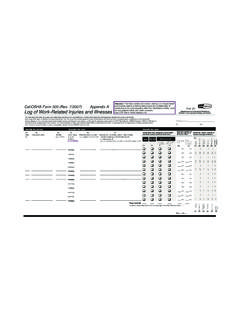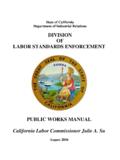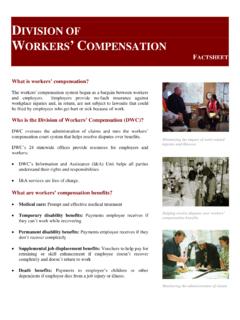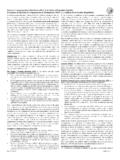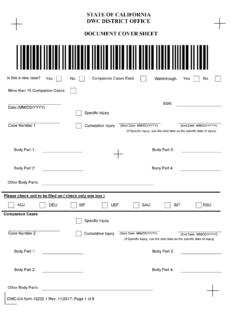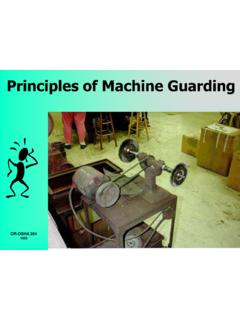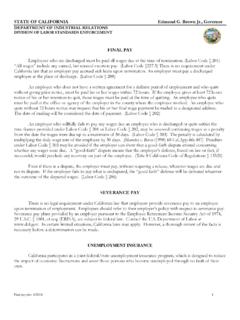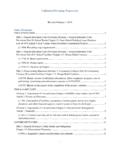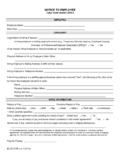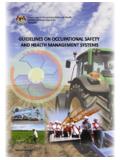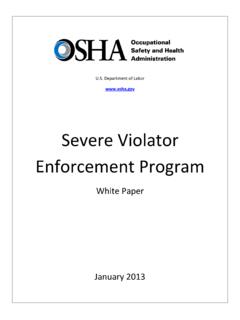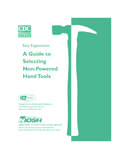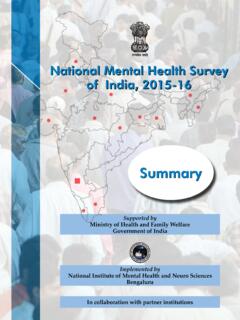Transcription of HAND, WRIST, AND FOREARM DISORDERS GUIDELINE
1 1 Copyright 2016 Reed Group, Ltd. HAND, WRIST, AND FOREARM DISORDERS GUIDELINE Effective June 30, 2016 CONTRIBUTORS TO THE HAND, WRIST, AND FOREARM DISORDERS GUIDELINE Editor-in-Chief: Kurt T. Hegmann, MD, MPH, FACOEM, FACP Evidence-based Practice Hand, Wrist, and FOREARM Panel Chair: J. Mark Melhorn, MD, FAAOS, FACOEM, FAADEP, FACS, FASSH, FAAHS Evidence-based Practice Hand, Wrist, and FOREARM Panel Members: James Ausfahl, MD M. Felix Freshwater, MD Charles P. Prezzia, MD, MPH, MMM, FACOEM David M. Rempel, MD, MPH, FACOEM, FACP Shawn C. Roll, PhD, OTR/L, RMSKS, FAOTA Arlen J. Rollins, DO, MSc, FACOEM, FACPM Robert A. Werner, MD, MS, FAAPMR Jason Zaremski, MD, CAQSM These panel members represent expertise in occupational medicine, orthopedic surgery, hand surgery, occupational therapy, physical medicine and rehabilitation, sports medicine, internal medicine, family practice, forensic medicine, and electrodiagnostic medicine. As required for quality guidelines (Institute of Medicine s [IOM] Standards for Developing Trustworthy Clinical Practice Guidelines and Appraisal of Guidelines for Research and Evaluation [AGREE]), a detailed application process captured conflicts of interest.
2 The above Panel has none to declare relevant to this GUIDELINE . Methodology Committee Consultant: Kurt T. Hegmann, MD, MPH, FACOEM, FACP Managing Editors: Production: Marianne Dreger, MA Research: Julie A. Ording, MPH Copyright 2008-2016 by Reed Group, Ltd. Reprinted from ACOEM s Occupational Practice Guidelines, with permission from Reed Group, Ltd., All rights reserved. Commercial use prohibited. Licenses may be purchased from Reed Group, Ltd. at 2 Copyright 2016 Reed Group, Ltd. Research Conducted By: Kurt T. Hegmann, MD, MPH, FACOEM, FACP Matthew A. Hughes, MD, MPH Matthew S. Thiese, PhD, MSPH Ulrike Ott, PhD, MSPH Deborah Gwenevere Passey, PhDc, MS Atim Effiong, MPH Kristine Hegmann, MSPH, CIC Alzina Koric, MPP Brenden Ronna, BS Austen J. Knudsen Pranjal A. Muthe Skyler Walker Anh Tran Jenna K. Lindsey Dillon J. Fix Leslie MC Echeverria, BS Jeremiah L. Dortch, BS Specialty Society and Society Representative Listing: ACOEM acknowledges the following organizations and their representatives who served as reviewers of the Hand, Wrist, and FOREARM DISORDERS GUIDELINE .
3 Their contributions are greatly appreciated. By listing the following individuals or organizations, it does not infer that these individuals or organizations support or endorse the hand, wrist, and FOREARM treatment guidelines developed by ACOEM. American Academy of Physical Medicine & Rehabilitation American Association of Occupational health Nurses David A. Allcott, MSN, APRN, ANP-BC, COHN-S, FAAOHN Association for Applied Psychophysiology and Biofeedback Gabriel E. Sella, MD, MPH, MSC, PhD, FAADP, FAAFP, FACPM American College of Emergency Physicians Charles Gerardo, MD, MHS, FACEP American Society of Anesthesiologists Richard W. Rosenquist, MD The American Occupational Therapy Association, Inc. Debbie Amini, EdD, OTR/L, CHT, FAOTA 3 Copyright 2016 Reed Group, Ltd. Impact Hand, wrist, and FOREARM symptoms in the workforce are common problems presented to health care providers and are among the five most common causes of reported work-related health symptoms and workers compensation claims.
4 According to 2010 US Census data, there was an incidence rate of upper extremity fractures per 10,000 persons.(1) In 2013, there were 345,560 work-related upper extremity DISORDERS for an incident rate of per 10,000 full-time workers.(2) This was the leading cause of work-related injury,(2) and it is estimated that 20% of the population in any given month will complain of at least one type of upper limb disorder.(3) In 1998, a study involving more than 10,800 participants concluded that had a self-reported neck or limb disorder.(4) Results from another study concluded that in 2000, out of every 1,000 workers would take an absence due to sickness because of a musculoskeletal upper limb disorder; by 2004 this number had risen to (5) These DISORDERS account for nearly one-third ( ) of the missed days of work.(2) They also account for about 7 to 8% of total lost workdays in workers compensation and 17 to 23% of cases and claims, ranking them in the top five for financial severity.
5 Overview Recommendations on assessing and treating adults with hand, wrist, and FOREARM DISORDERS are presented in this clinical practice GUIDELINE . Topics include the initial assessment and diagnosis of patients with acute, subacute, and chronic hand, wrist, and FOREARM DISORDERS that are potentially work-related, identification of red flags that may suggest the presence of a serious underlying medical condition, initial management, diagnostic considerations and special studies to identify clinical pathology, work-relatedness, modified duty and activity, and return to work, as well as further management considerations including delayed recovery. The majority of peer-reviewed literature categorizes acute as <1 month duration, subacute as 1 to 3 months duration, and chronic as >3 months duration. These definitions have been adopted throughout this document. Throughout the GUIDELINE , we refer to costs in the rationale for the recommendation costs are defined as low (<$100), moderate ($100-$500), and high (>$500).
6 Algorithms for patient management are included and schematize how to generally manage acute, subacute, or chronic hand, wrist, and FOREARM DISORDERS . It is important to realize that there are few studies that evaluate patients with work-related hand, wrist, and FOREARM DISORDERS ; therefore, studies that include different populations were used to develop the recommendations. In addition, most studies that focus on pharmaceuticals, appliances, and specific devices are industry sponsored. In certain areas, this may have made little difference as the comparisons were between the medication and placebo and the results may be stark. However, in other studies, the comparison groups may have been suboptimally treated ( , a low-dose of ibuprofen) and produced a bias in favor of the medication or device. In addition, industry-sponsored studies have been shown to frequently have better results and lower complication rates than studies conducted by independent investigators. Readers should refer to the Low Back DISORDERS , Chronic Pain and Opioids guidelines for more information regarding medications, including adverse effects.
7 General Approach and Basic Principles The principal recommendations for assessing and treating patients with acute, subacute, or chronic hand, wrist, or FOREARM symptoms are as follows: The initial assessment focuses on detecting indicators of potentially serious disease, termed red flags, which require urgent assessment and treatment as indicated. The foci for treatment of patients with hand, wrist, or FOREARM symptoms include optimal medical care, monitoring for complications, facilitating the healing process, assisting stay at work or early return to work in a modified or full-duty capacity, and include surgical intervention(s) when indicated. Relieving discomfort can frequently and most safely be accomplished by modifying activities and using either topical or systemic nonprescription analgesics. Encourage patients recovering from hand, wrist, or FOREARM problems to stay at work or consider early return to modified work as their condition permits. Address occupational factors where the disorder is believed to be caused by work.
8 4 Copyright 2016 Reed Group, Ltd. Address nonphysical factors ( , psychosocial, workplace, or socioeconomic problems) in an effort to resolve delayed recovery (see Cornerstones of Disability Prevention and Management and Chronic Pain guidelines). This GUIDELINE addresses the following hand, wrist, and FOREARM DISORDERS which may present to the health care provider. Carpal Tunnel Syndrome CTS is the most common and widely known of the entrapment neuropathies in which the body s peripheral nerves are compressed or traumatized,(6-11) affecting an estimated 4 to 10 million Americans.(9) Carpal tunnel syndrome (CTS) occurs when symptoms occur that are attributable to abnormal median nerve compression within the carpal tunnel a narrow, rigid passageway of ligament and bones at the base of the hand, which houses the median nerve and flexor tendons. The median nerve supplies sensations to the palmar aspect of the thumb, index, middle and radial half of the ring finger, as well as the dorsal segment of each of those four digits from the DIP distally, but not the fifth digit, as well as innervation to some small muscles (lateral two lumbricals, opponens pollicis, abductor policis brevis and flexor pollicis brevis.)
9 In the hand that allow the fingers and thumb to move. Often, the condition arises without apparent cause.(6, 12, 13) Patients who have open injuries, unstable fractures, wrist fractures, or acute gout attack that results in acute CTS require immediate referral to a surgeon since improvement may only be obtained through surgery. Sometimes, synovial thickening around tendons or other swelling narrow the carpal tunnel and cause the median nerve to become variously compressed or enlarged through poorly understood processes. The result may be tingling, numbness, pain, or weakness in the digits. Tingling and numbness are essential symptoms. Pain is not an essential symptom and it may indicate other conditions, but if present, may also radiate proximally. Triangular Fibrocartilage Complex (TFCC) Tears Triangular fibrocartilage complex (TFCC) tears are frequent wrist injuries involving the cartilaginous meniscus between the radius and ulna with symptoms often described as occurring on the ulnar side of the wrist joint.
10 TFCC is apparently susceptible to the same anatomic, pathophysiologic, and degenerative issues as the knee menisci. Vascular supply is similarly analogous to a meniscus with radial penetration into the meniscal periphery and central avascularity(14, 15) and evidence that degeneration increases with age.(16) Since abnormalities are commonly found on MRI and/or arthrography,(17) indications for surgical interventions are somewhat unclear. Crush Injuries and Compartment Syndrome Crush injuries as well as compartment syndrome are usually surgical emergencies.(18, 19) Mild cases of crush injuries may be treated similar to non-specific hand, wrist, FOREARM pain with particular emphasis on RICE (rest, ice, compression, elevation). Not all crush wounds, especially those more extensive and prone towards swelling are sutured as additional problems may ensue from suturing including possible tissue necrosis and the intervention may help to inhibit expansion to relieve pressure. Kienb ck Disease Kienb ck disease involves changes in the lunate that eventually lead to collapse of the lunate bone, which results in progressive pain and disability.
